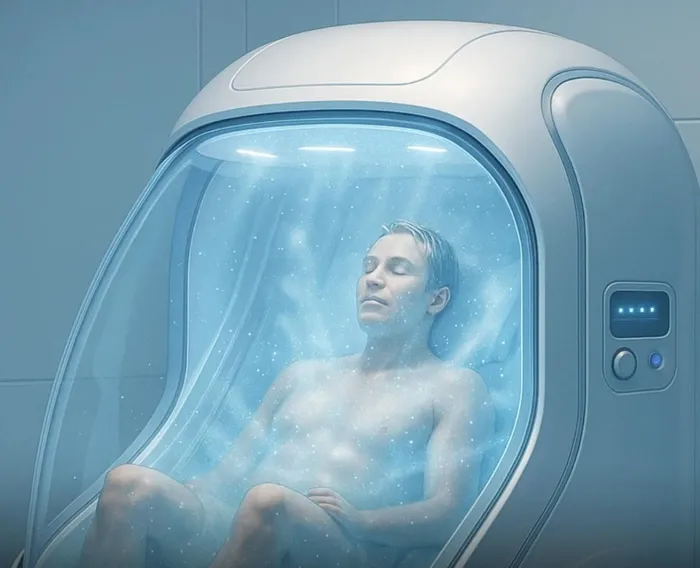Human ‘washing machine’ makes a splash! Meet the AI-based invention that cleans you in just 15 minutes

The Mirai Ningen Sentakuki, developed by Osaka-based Science Co., is an AI-powered bathing device designed for both convenience and wellness.
Image: Instagram
The future is here!
Imagine a pod-like shower that seems straight out of a science fiction movie, but it could soon be part of our daily lives.
This is thanks to Japan's latest invention, the Mirai Ningen Sentakuki, also called the “human washing machine".
Developed by the Osaka-based company Science Co., this AI-powered bathing device is built for both convenience and wellness.
It uses advanced water jets, microscopic air bubbles and a smart system that adapts to your body’s needs.
The machine could change the way we think about personal hygiene.
More importantly, it could hold life-changing potential for elderly people and caregivers around the world.
How does the machine work?
The process is simple but futuristic: You step into a capsule-like pod, which fills halfway with warm water.
High-speed jets release billions of microscopic bubbles that gently burst against the skin, lifting away dirt and bacteria without harsh scrubbing.
An AI system monitors vital signs, adjusting water temperature, bubble density and pressure in real time for maximum comfort.
To enhance relaxation, the machine projects calming visuals inside the pod and analyses the user’s emotional state to tailor the experience.
For many older adults, something as basic as bathing can become a daily struggle.
Research on why bathing is challenging for elders and caregivers highlights how bathing assistance is one of the most physically and emotionally challenging caregiving tasks, often linked to stress, caregiver burnout and even accidental injuries.
The process is tiring for caregivers and can compromise the dignity of those who need help.
This is where the human washing machine could make a difference.
With minimal physical effort required, the device may give elderly people a sense of independence while easing the burden on caregivers.
While some social media users laughed at the concept, others saw its life-changing potential.
“Where’s the machine that can eat, drink, poo and pee for us?” joked one commenter.
User Monishikha Das summed it up best: “This would be welcome for the elderly who may be finding it difficult to take a bath.” That one comment hits at the heart of the invention’s value.
Anyone who has ever cared for a bedridden relative knows the emotional weight of this task.
Supporting someone in and out of a bathtub or shower can be physically demanding and potentially hazardous.
Falls, slips and caregiver back injuries are common.
By automating the process in a safe, controlled environment, this invention could improve not only hygiene but also safety, dignity and quality of life.
From concept to reality
Interestingly, this is not a completely new concept.
Sanyo Electric tried with a similar concept in the 1970s, but the technology was not yet advanced enough.
Fast forward to today, and Science Co. has reinvented the design with cutting-edge AI and microbubble technologies.
According to a Japanese publication, Asahi Shimbun, the machine is set to debut at the 2025 Osaka Expo, where around 1,000 attendees will get to experience it firsthand.
Following its trial, the company hopes to launch mass production and even roll out a home-use edition.
Reservations for the automated bathtub are already open on the company’s website.
“We’re about 70 percent there,” said Science Co. chairman Yasuaki Aoyama during a lecture last year.
“We plan to offer 1,000 general visitors an opportunity to use it during the expo.”
The world’s populations are rapidly aging. The World Health Organisation (WHO) predicts that by 2030, 1 in 6 people globally will be over 60.
Could this change caregiving forever?
If successful, the Mirai Ningen Sentakuki could open new possibilities for home care, assisted living facilities and hospitals.
Instead of viewing bathing as a difficult, time-consuming task, caregivers might rely on technology to take over the physical strain, allowing them to focus on companionship and emotional support.
Of course, questions remain.
Will it be affordable? Will it be safe for people with sensitive skin or medical conditions? And can a machine truly replicate the gentle human touch that makes care feel personal?
This invention may not replace traditional care, but it could complement it powerfully.
For families dealing with the difficulties of bathing a bedridden loved one, the prospect of a machine that restores dignity and comfort is hopeful.